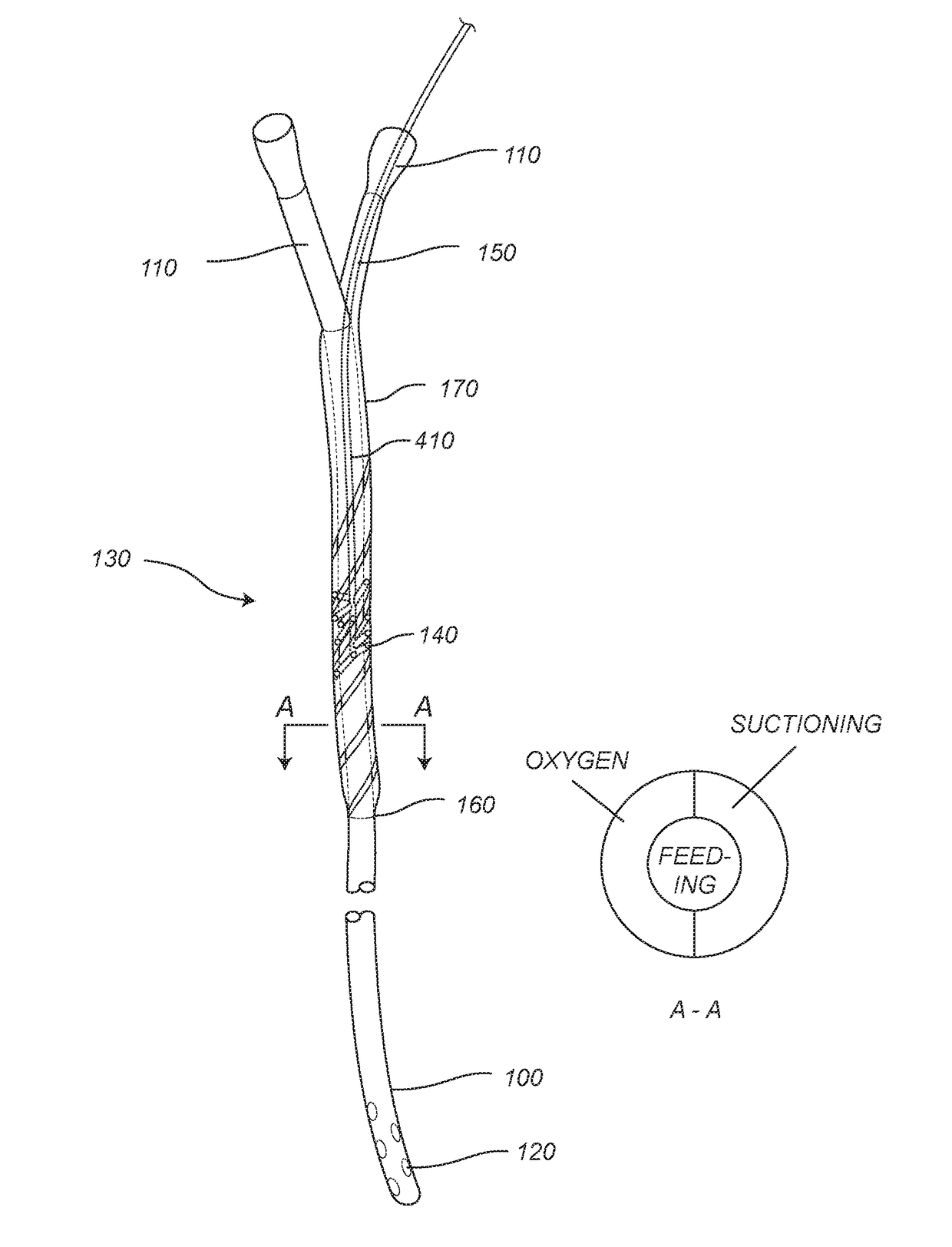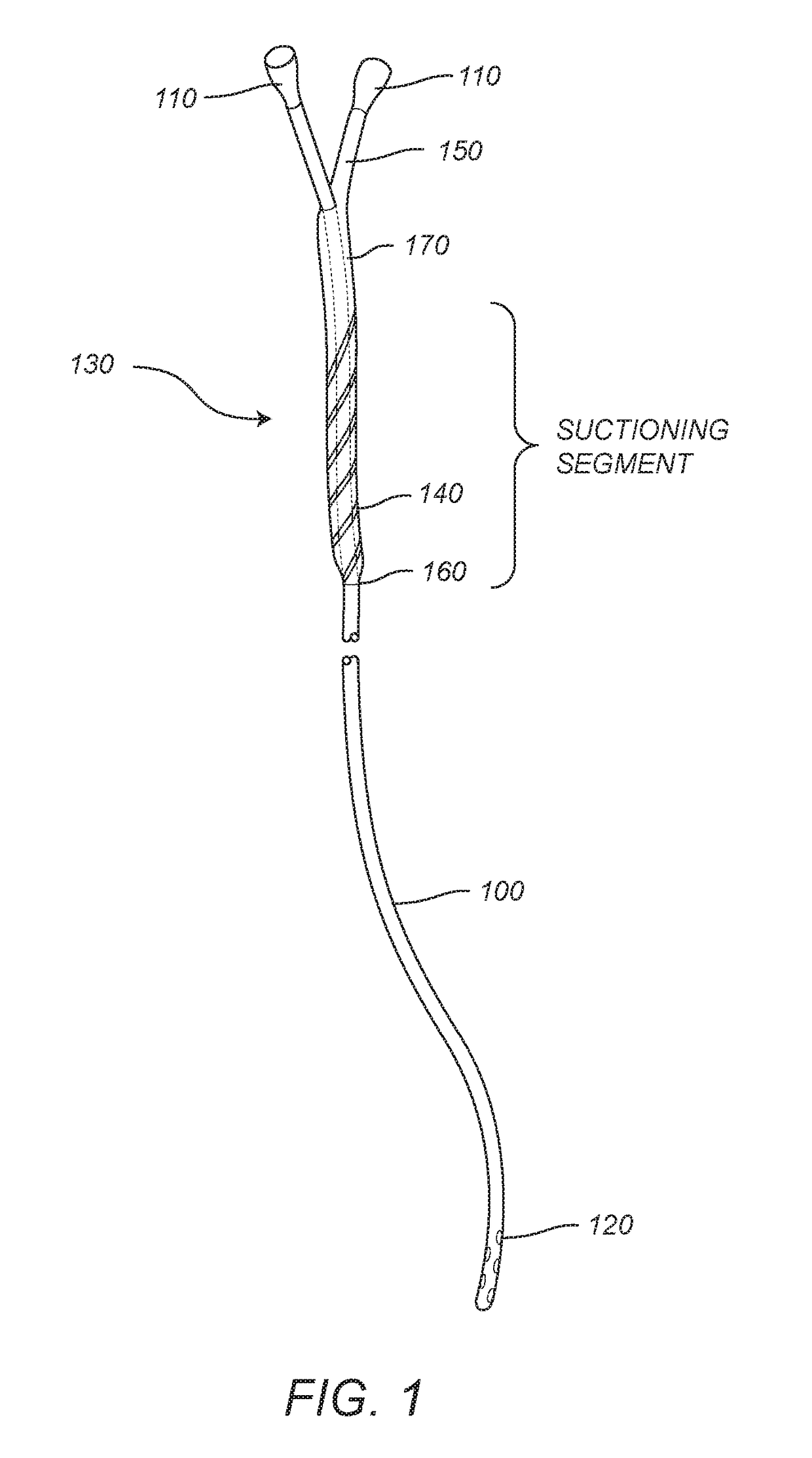Pharyngeal-enteric tube combination
a technology of pharyngeal and gastrointestinal tract, applied in the field of pharyngeal-enteric tube combination, can solve the problems of laceration of mucous membranes, ongoing daily material cost, and inability to reliably provide supplemental oxygen, so as to facilitate a secretion-free environment, improve patient autonomy, and improve measurable outcome
- Summary
- Abstract
- Description
- Claims
- Application Information
AI Technical Summary
Benefits of technology
Problems solved by technology
Method used
Image
Examples
embodiment 1
[0061] A suction tube for suctioning a patient's pharynx, the suction tube comprising: a connection port for connecting to a vacuum source and a collector; a suction section; and an enteric tube, wherein the suction section comprises a perforations and a lumen, wherein the perforations is configured to be in fluid communication with the lumen, wherein the lumen is configured to be in fluid communication with the connection port, wherein the suction section is configured to be connectable to outer portion of the enteric tube, wherein when the suction section is configured to be connectable to the enteric tube, and wherein the lumen is retained between the outer portion of the enteric tube and inside of the suction section.
[0062]Embodiment 2. The suction tube of embodiment 1, wherein the perforations comprise slots that are formed along the suction section in a longitudinally sloped orientation.
[0063]Embodiment 3. The suction tube of embodiment 1, wherein the suction section is slidab...
embodiment 9
[0069] A combination suction and enteric feeding system for feeding a patient and suctioning the patient's pharynx comprising: an enteric tube comprising an enteric lumen, an opening at a distal end of the enteric tube, a first connection port for connecting the enteric tube to a food source; and a suction tube connected to at least a portion of the enteric tube, wherein the suction tube comprises: a second connection port for connecting the suction tube to a vacuum source; and a suction lumen, wherein the suction lumen is configured to be in fluid communication with the second connection port and perforations that open to outside of the suction tube.
[0070]Embodiment 10. The system of embodiment 9, wherein the suction lumen is formed between outside of the enteric tube and inside of the suction tube in a coaxial relationship.
[0071]Embodiment 11. The system of embodiment 9, wherein the suction lumen is adjacent to and not coaxial with the enteric lumen.
[0072]Embodiment 12. The system...
embodiment 15
[0075] A method of suctioning a patient's pharynx while feeding the patient comprising: connecting a suction tube to an enteric tube to form a lumen around outer portion of the enteric tube and to form an airtight seal around the enteric tube, wherein the suction tube comprises: perforations that are in fluid communication with the lumen and a connector port that is configured to be in fluid communication with the lumen; inserting the connected suction and enteric tubes into the patient so that a distal end of the enteric tube is positioned in the patient's stomach and the perforations are positioned inside the patient's pharynx; connecting the suction tube to a vacuum source; and initiating suction of the vacuum source to aspire the patient's pharynx and remove secretions in the patient's pharynx.
[0076]Embodiment 16. The method of embodiment 15, wherein the enteric tube is configured to be removably connected to a food source so that food can be inserted directly into the patient's...
PUM
 Login to View More
Login to View More Abstract
Description
Claims
Application Information
 Login to View More
Login to View More - R&D
- Intellectual Property
- Life Sciences
- Materials
- Tech Scout
- Unparalleled Data Quality
- Higher Quality Content
- 60% Fewer Hallucinations
Browse by: Latest US Patents, China's latest patents, Technical Efficacy Thesaurus, Application Domain, Technology Topic, Popular Technical Reports.
© 2025 PatSnap. All rights reserved.Legal|Privacy policy|Modern Slavery Act Transparency Statement|Sitemap|About US| Contact US: help@patsnap.com



